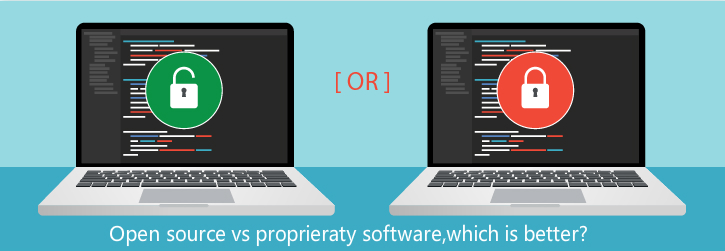Open source software allows the source code to be shared, viewed and modified by users, while proprietary software doesn’t. Open source software provides more flexibilities like programming the network or adding applications, but proprietary is designed for out-of-the-box usage. When it comes to choosing one for business purposes, IT staff generally come across the question, open source vs proprietary software, which is better? To find this out, make sure you know the basic information and differences between the open source and proprietary software.
What Is Open source Software?
Open source software (OSS) is often regarded as free software. The word free means it gives users the freedom to run it, study it and change it, meanwhile users also can redistribute copies with or without changes. In other words, OSS is software with source code that anyone can inspect, modify and enhance. For example, as for open networking, the open source software can be installed on a bare metal hardware such as a Gigabit Ethernet switch so as to make the network switch “do things” like developing software, running application and more. With open source software, IT organizations have the flexibility to write and add applications, or modify the source code and update setting without waiting for the vendors’ permissions, which can increase working efficiency and avoid vendor lock-in. Besides, users have a more flexible choice that they can install open source software by themselves or buy a network switch preloaded with open source software.
What Is Proprietary Software?
In contrast, proprietary software could be considered as closed software, the source code for which is closed and proprietary. Usually, proprietary software is installed on hardware, and the combination is generally sold as a commercial product for users. In this way, users can not get one without the other one. For instance, if someone wants to buy Cisco Catalyst 6500 series switches, he has to pay for both the hardware (physical switch) and software (Cisco IOS). Using proprietary software, users can enjoy a “one stop shopping” experience whereby a single vendor can offer all the applications and tools you need, and the routine updates are also included. Besides, it’s designed for out-of-the-box usage without programming requirements.
Open Source vs Proprietary Software: Difference
Generally, the differences between open source vs proprietary software come down to a few factors.
This is the most obvious difference. If one user decides to buy a 24 port managed switch, there is no doubt that he would spend more for a traditional network switch. Because IT person can choose a cheaper bare metal switch of the same type, and cheaper open source software. Thus, with open source software, the total cost is much lower, which helps reduce initial investment. However, customers should notice that open source software like Cumulus Linux requires a certain level of specialized skill to operate and maintain it.
For proprietary software, the cost varies greatly depending on the complexity of the software and hardware since it’s always sold with the hardware. For example, due to different software (ICOS system, ZebOS system) and hardware chips (Microsemi, Broadcom ), the cost of 10Gb Ethernet switch on the market varies greatly.
Open source software offers a high level of flexibility and freedom to change the applications without restriction. But Open source software is not being straightforward to use. Open source operating system like Cumulus Linux can not be learned in one day. Customers need to learn the control programming language or operations first. In addition, before you buy the open source software, you have to check whether your hardware is compatible with the open source platform.
As mentioned above, proprietary software is designed for out-of-the-box usage, so it doesn’t require programming. And customers can receive professional support and routine upgrades from the vendors, which is a key selling point for users with little technical skills. However, proprietary software only allows users to add the applications that have been authorized, which is a big drawback for some engineers.
It’s no doubt that this is the biggest advantage of open source software. Customers can modify the function and add community-created modifications or features to suit their network needs, which tends to scale up easier. In addition, customers’ choices become more flexible. They can buy a bare metal switch and the third party open source software, or they can choose a brite box switch from some vendors such as FS. FS N-series switches have been preloaded with Cumulus Linux, providing advanced features like EVPN, MLAG SNMP etc. And customers can receive one-stop tech support from FS and Cumulus. On the other hand, proprietary software is restricted by vendors, and the flexibility only extends to the front-end because the functions are limited to what has been programmed.
Open Source vs Proprietary Software: Which Is Better?
As for open source vs proprietary software, the differences are fairly straightforward and there are clear pros and cons for each. Open source software offers more flexibility for IT staff to add or modify applications with lower cost, which avoid vendor lock-in. But it requires the IT persons to know the software operations such as Linux, which is quite well for the organizations with the experts who can operate Linux. While proprietary software offers “one stop shop” support for customers, which is easier to work with for those who don’t know how to run Linux. Therefore, the wise choice should base on your company’s needs.
